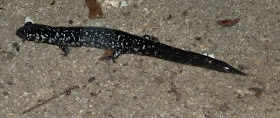The occurrence of the Baltimore checkerspot butterfly (Euphydryas phaeton ozarkae) in the Missouri Ozarks.
by Linda S. Ellis
During the late summer of 1999, I was out in a dry wooded
area in southwest Missouri and came upon a stand of blooming false
yellow foxglove (
Aureolaria flava), a plant in the snapdragon family
(Scrophulariaceae). Always looking for camera fodder, I went over to
examine the plants more closely. I noticed a couple of the plants had
webbing in the top branches. “What in the world is a web worm doing on
this plant in August?” I said to myself. I looked at the still-small
caterpillars in the webbing and realized this was no fall web worm
species I knew. After taking a number of slides (I used an SLR style
camera back then), I went back to my books and soon realized I had
photos of the silk nest of the Baltimore checkerspot on my camera.
 |
| Baltimore checkerspot web |
I found out the location of this particular web was at the western edge
of the known range of this butterfly and that it is “wide-spread but
local in the Ozarks”, according to
Butterflies and Moths of Missouri by
Richard and Joan Heitzman. The adult female checkerspot seeks out any
number of plant species in the snapdragon family on which to lay 100 -
600 eggs under the larger leaves. Some of the other recorded species
the females have chosen for egg laying are white turtlehead (
Chelone
glabra), beardtongue (
Penstemon sp.), mullein foxglove (
Dasistoma
macrophylla), monkey flower (
Mimulus ringens), carpenter’s square
(
Scrophularia marylandica) and the larger speedwells (
Veronica sp.), all
in the snapdragon family. Occasionally the eggs are laid on other
plant species like plantain and members of the honeysuckle family
(Caprifoliacaea) including buck brush (
Symphoricarpus orbiculatus).

The hatchling larvae climb to the top of the plant, in this case the
false yellow foxglove, and begin to spin an increasingly dense web nest
as they feed on the foliage. The problem with having such a conspicuous abode is the
nest is liable to be torn or destroyed by a passing deer or hail storm
and it isn’t hard for predators to spot such a collection of goodies,
either. Parasitoides can and do lay eggs into the resting larvae right
through the webbing. Larger predators, such as blue jays, avoid these
caterpillars since feeding on plants in the snapdragon family give them a
toxicity similar to the monarch/milkweed association.

The
young larvae live gregariously, moving around the host plant by day but
returning to the web for rest or diapause. As the individuals develop,
they molt right inside the webs and go through 4 stages of growth or
instars. When they reach the 4th stage, some time in the fall, they
travel down the plant and build a different kind of silk shelter in the
leaf litter to over-winter.

In spring, the 4th stage
larva supposedly seeks out the same plant types it fed on as a younger
caterpillar but, in my experience, the larvae never showed up again on
the false yellow foxglove but sought out the wood betony (
Pedicularis
canadensis) plants in the area. I suspect this is because wood betony
or louse wort (who names these things?) is available early on which to
feed while the other Scrophulariaceae emerge later in spring.
Since
that first encounter in 1999, I have followed the seasons of the Baltimore checkerspot where I first discovered them. Some years they
were abundant and predictable in their appearance and some years sparse
or found on alternate plants. During the flooding of 2008, the nearly
constant rain destroyed the web nests and I wondered if they would
disappear from the area. I found the checkerspots again in 2009 on
mullein foxglove (
Dasistoma) this time. This plant tends to grow in more
sheltered areas beneath trees along creeks and waterways and one can
conjecture it would be a less hazardous place to exist than the habitat
of false yellow foxglove which prefers dry forest openings.
 |
Mullein foxglove
(Dasistoma macrophylla) |
In 2010 there was a large hatching of the checkerspots but 2011 had us right back
in the flooding. I found no checkerspots that year, adult or larvae,
nor during the severe drought year of 2012. Happily, this spring, 2013,
I spotted an adult male feeding on coneflower nectar while waiting for a
passing female. Apparently, once the Baltimore checkerspot finds an
area they like, they tend to return so I’ll be hunting for webbing soon
to see if they have come back to stay.
 |
Adult taking nectar from purple
milkweed
(Asclepias purpurascens) |
The Baltimore checkerspot, as the name implies, exists in the eastern part of America and this version (
Euphydryas phaeton phaeton) is a smaller creature with more orange on the upper wings than our “ozarkae” version. Out east, it prefers wet meadows where it finds turtlehead plants but here in the Ozarks look for it in dry mesic woods. The next time you see webbing in a woodland plant around southwest Missouri, take a minute to see if you’ve found a checkerspot colony. Enjoy!
Contact me: botanyart@www.lindasellis.com




































_with_Cicada.jpg)















